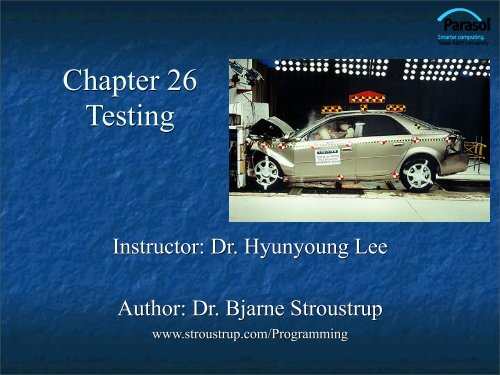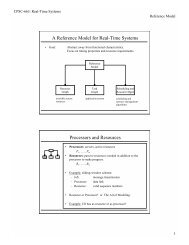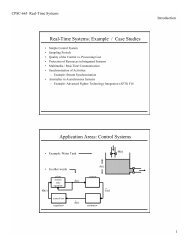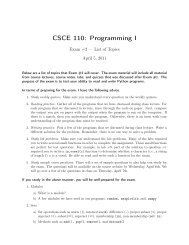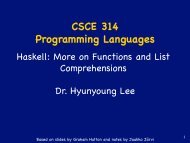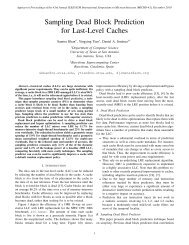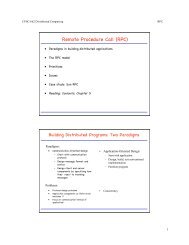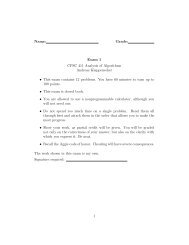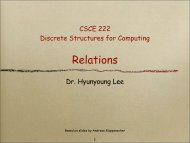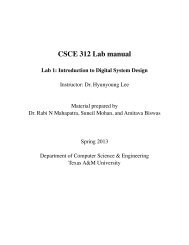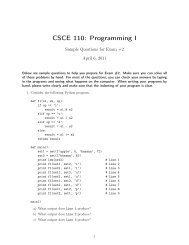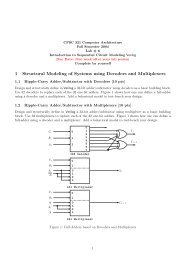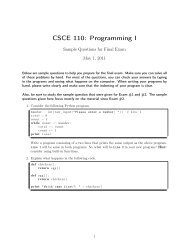Ch.26 Testing - TAMU Computer Science Faculty Pages
Ch.26 Testing - TAMU Computer Science Faculty Pages
Ch.26 Testing - TAMU Computer Science Faculty Pages
Create successful ePaper yourself
Turn your PDF publications into a flip-book with our unique Google optimized e-Paper software.
Chapter 26<strong>Testing</strong>Instructor: Dr. Hyunyoung LeeAuthor: Dr. Bjarne Stroustrupwww.stroustrup.com/Programming
Abstract This lecture is an introduction to the design andtesting of program units (such as functions andclasses) for correctness. We discuss the use ofinterfaces and the selection of tests to run againstthem. We emphasize the importance of designingsystems to simplify testing and testing from the start.Proving programs correct and performance problemsare also briefly considered.2
Overview Correctness, proofs, and testing Dependencies System tests <strong>Testing</strong> GUIs Resource management Unit and system tests Finding assumptions that do not hold Design for testing Performance3
CorrectnessQuestions to ask about a programIs your program correct?What makes you think so?How sure are you?Why?Would you fly in a plane that depended on that code?You have to be able to reason about your code to have any realcertaintyProgramming is generally unsystematicDebugging is generally unsystematicWhat are you willing to bet that you found the last bug?Related interesting questionsCould the program run forever if the hardware didn’t fail?Does it always deliver its results in a reasonable time?4
ProofsSo why not just prove mathematically that our program iscorrect?It’s often too hard and/or takes too longSometimes proofs are wrong too (even proofs produced by computers orby experts).<strong>Computer</strong> arithmetic isn’t the same as “real” math—remember therounding and overflow errors we saw (due to finite and limitedprecision)?So we do what we can: follow good design principles, test, test, and thentest some more!5
<strong>Testing</strong>“A systematic way to search for errors”Real testers use a lot of toolsUnit test frameworksStatic code analysis toolsFault injection tools …When done well, testing is a highly skilled and most valuableactivity“Test early and often”Whenever you write a function or a class, think of how you might test itWhenever you make a significant change, re-testBefore you ship (even after the most minor change), re-test6
<strong>Testing</strong>Some useful sets of values to check (especially boundary cases):the empty setsmall setslarge setssets with extreme distributionssets where “what is of interest” happens near the endssets with duplicate elementssets with even and with odd number of elementssome sets generated using random numbers7
A Better Test Harness (still primitive)Put the variables into a data file, e.g., with a format of{ 27 7 { 1 2 3 5 8 13 21} 0 }meaning{test_number value {sequence} result}i.e., test #27 calls our binary_search to look for the value 7 in thesequence { 1 2 3 5 8 13 21} and checks that the result is 0 (false, thatis, not found).Now it’s (relatively) easy to write lots of test cases, or even write anotherprogram to generate a data file with lots of (random) cases.9
DependenciesBasically we want every function to:have well-defined inputshave well-defined results including any modifications to input parameters in a determinate amount of time (no infinite loops, please)not have dependencies on objects that are not its explicit inputsHard to achieve in real lifenot use more resources than are available and appropriateE.g., time, memory, internet bandwidth, files, and locks10
DependenciesHow many dependencies can you spot in this nonsense function?int do_dependent(int a, int& b) // messy function// undisciplined dependencies{int val ;cin>>val;vec[val] += 10;cout
Resource ManagementWhat resources (memory, files, etc.) acquired may not always beproperly released in this nonsense function?void do_resources1(int a, int b, const char* s) // messy function// undisciplined resource use{FILE* f = fopen(s,"r"); // open file (C style)int* p = new int[a]; // allocate some memoryif (b
Better Resource Management// less messy functionvoid do_resources2(int a, int b, const string& s){istream is(s.c_str(),"r"); // open filevectorv1(a);// create vector (owning memory)if (b
LoopsMost errors occur at the ends, i.e., at the first case or thelast case. Can you spot 3 problems in this code? 4? 5?int do_loop(vector& vec) // messy function// undisciplined loop{int i;int sum;while(i
Buffer OverflowReally a special type of loop error, e.g., “storing more bytes thanwill fit” into an array—where do the “extra bytes” go?(probably not a good place)The premiere tool of virus writers and “crackers” (evil hackers)Don’t avoid unsafe functions just as a fetishUnderstand what can go wrong and don’t just write equivalent codeEven unsafe functions (e.g. strcpy()) have uses: if you really want to copy a zeroterminated string, you can’t do better than strcpy() – just be sure about your“strings” (How?)15
Buffer overflowDon’t avoid unsafe functions just as a fetishUnderstand what can go wrong and don’t just write equivalent codewrite simple and safe codeEven unsafe functions (e.g. strcpy()) have uses if you really want to copy a zero terminated string, you can’t do better than strcpy() –just be sure about your “strings” (How?)char buf[MAX];char* read_line() // harmless? Mostly harmless? Avoid like the plague?{ int i = 0;char ch;while (cin.get(ch) && ch!='\n') buf(i++)=ch;buf[i+1]=0;return buf;}16
BranchingIn if and switch statementsAre all alternatives covered?Are the right actions associated with the right conditions?Be careful with nested if and switch statementsThe compiler ignores your indentationEach time you nest you must deal with all possible alternativesEach level multiplies the number of alternatives (not just add)For switch statementsremember the default case and to break after each other caseunless you really meant to “fall through”17
System TestsDo unit tests first, then combinations of units, and so on, till weget to the whole systemIdeally, in isolation from other parts of the systemIdeally, in a repeatable fashionWhat about testing GUI based applications? Control inversion makes GUI testing difficultHuman behavior is not exactly repeatableTiming, forgetfulness, boredom, etc.Humans still needed at some point (only a human can evaluate “look and feel”)Simulate user input from a test scriptThat way a test harness script takes the place of the human for many testsAn excellent application of “layering” with well-defined interfacesbetween the layersAllows for portability of applications across GUI systemsA GUI is often used as a lock-in mechanism18
<strong>Testing</strong> ClassesA type of unit testbut most class objects have stateClasses often depend on interactions among member functionsA base class must be tested in combination with its derived classesVirtual functionsConstruction/initialization is the combined responsibility of several classesPrivate data is really useful here (beware of protected data members)Take our Shape class as an example:Shape has several functionsA Shape has a mutable state (we can add points, change color, etc.); that is,the effect of one function can affect the behavior of another functionShape has virtual functions; that is, the behavior of a Shape depends onwhat (if any) class has been derived from itShape is not an algorithm (why not?)A change to a Shape can have an effect on the screen (so maybe we stillneed a human tester?)19
Finding assumptions that do not holdFor example, illegal input argumentsShould never happen, but it doesCheck before each call or at the beginning of the functionDepending on which code we can modifyE.g., sqrt first checks that its argument is a non-negative valueThat can be difficult/problematic: Consider binary_search(a,b,v); // is v in [a:b) For forward iterators (e.g., for a list), we can’t test if a
Design for <strong>Testing</strong>Use well-defined interfacesso that you can write tests for the use of these interfacesDefine invariants, pre- and post conditionsHave a way of representing operations as textso that they can be stored, analyzed and replayedEmbed tests of unchecked assumptions (assertions) in the callingand/or called codeto catch bad arguments before system testingMinimize dependencies and keep dependencies explicitTo make it easier to reason about the codeHave a clear resource management strategyThis will also minimize debugging!21
Performance Is it efficient enough? Note: Not “Is it as efficient as possible?” <strong>Computer</strong>s are fast: You’ll have to do millions of operationsto even notice (without using tools) Accessing permanent data (on disc) repeatedly can be noticed Accessing the web repeatedly can be noticed Time “interesting” test cases e.g., using time or clock() Repeat ≥3 times; should be ± 10% to be believable22
Performance What’s wrong with this?for (int i=0; i
Using clock() (in header)int n = 10000000;// repeat do_somenting() n timesclock_t t1 = clock();if (t1 = = clock_t(-1)) { // clock_t(-1) means “clock() didn't work”cerr


